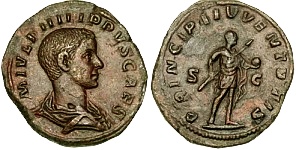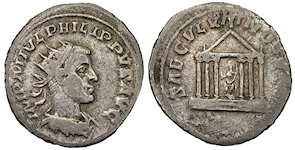Fine Coins Showcase
Antiquities Showcase
Show Empty Categories
Shop Search
Shopping Cart
My FORVM
Contact Us
About Forum
Shopping at Forum
Our Guarantee
Payment Options
Shipping Options & Fees
Privacy & Security
Forum Staff
Selling Your Coins
Identifying Your Coin
FAQs
zoom.asp
Home ▸ Catalog ▸ |Roman Coins| ▸ |Crisis & Decline| ▸ |Philip II||View Options:   | | | | | | Marcus Julius Philippus Severus (Philip II) was the son of the Philip the Arab by his wife Marcia Otacilia Severa. He was six years old when, in February or March 244, his father became emperor and he was made caesar. In 247, he was consul, and in July or August, he was elevated to Augustus and co-ruler. His father was killed in battle by his successor Decius in late 249. When news of this death reached Rome, Philip II was murdered by the Praetorian Guard. He died in his mother's arms, aged eleven years. |


When Augustus ruled Rome, he was not called emperor or king, he was the Princeps, the "first of men." In the empire, the designated successors to the emperor were named caesar and also given the title Princeps Juventutis, the "first of youths." This is the origin of the English word prince, meaning the son of a monarch.SL114189. Silver antoninianus, RIC IV 218d, RSC IV 48, Hunter V 8, SRCV III 9240, NGC MS, strike 5/5, surface 3/5, grainy (2406772-001), weight 4.02 g, maximum diameter 21 mm, die axis 0o, Rome mint, as caesar, 244 - 246 A.D.; obverse M IVL PHILIPPVS CAES, radiate and draped bust right, seen from behind; reverse PRINCIPI IVVENT (to the Prince of Youth), Philip II standing slightly left, head left, wearing military dress, globe in extended right hand, inverted spear in left hand; from the Craig Chambers Collection, NGC| Lookup; $300.00 (€282.00)
Philip II, July or August 247 - Late 249 A.D., Perge, Pamphylia


Hephaestus is the Greek god of fire, metalworking, craftsmen, sculpture, metallurgy and volcanoes. His parents were Zeus and Hera. On this reverse Hephaestus is depicted in his role as the blacksmith of the gods.RP114660. Bronze AE 23, RPC Online VIII U21074; BMC Lycia p. 132, 63; SNG BnF 516; SNGvA 4709; SNG Keckman II 660; Lindgren III 649; SNG Cop 351, F, porous, part of obv. legend weak, weight 8.655 g, maximum diameter 23.5 mm, die axis 0o, Perge (near Antalya, Turkey) mint, Jul/Aug 247 - Late 249 A.D.; obverse AY K M IOY CEOY ΦILIΠΠOC CE, laureate, draped and cuirassed bust right, globe below; reverse ΠEPΓAIΩN, Hephaestus seated right on rock, wearing pointed cap and himation leaving right shoulder bare, hammer in right hand, left hand supports sheild on left knee; ex Naville Numismatics auction 86 (17 Dec 2023), lot 258; $125.00 (€117.50)
Philip II, July or August 247 - late 249 A.D., Side, Pamphylia


RP114000. Bronze pentassarion, RPC Online VIII U21158, Watson 922, SNG BnF 867, SNG Pfalz 774, Waddington 3478, SNG Cop -, SNGvA -, F, dark patina, earthen deposits, porosity, weight 17.053 g, maximum diameter 32.1 mm, die axis 0o, Side (near Selimiye, Antalya Province, Turkey) mint, as caesar, 247 A.D.; obverse MAPKON IOYΛION CEYHPON ΦIΛIΠΠON KAICAPA (Marcus Iulius Severus Philippus Caesar), bare-headed, draped and cuirassed bust right, E (mark of value) lower right; reverse IC AI-ΩNA, two Nikai facing each other, holding between them an agonistic crown containing two palm fronds, TA ΠT/ΘIA (refers to Pythian games) in two lines below, CIΔHTΩN in exergue; ex CNG e-auction 549 (30 Oct 2023), lot 365; rare; $110.00 (€103.40)


When Augustus ruled Rome, he was not called emperor or king, he was the Princeps, the "first of men." In the empire, the designated successors to the emperor were named caesar and also given the title Princeps Juventutis, the "first of youths." This is the origin of the English word prince, meaning the son of a monarch.RB13706. Orichalcum sestertius, RIC IV 257, Cohen V -, Hunter III -, SRCV III -, gVF, very attractive coin with a nice portrait and beautiful cherry-brown patina, weight 19.327 g, maximum diameter 32.0 mm, die axis 0o, Rome mint, as caesar, 244 - 246 A.D.; obverse M IVL PHILIPPVS CAES, draped and cuirassed bust right, seen from behind; reverse PRINCIPI IVVENTVTIS (to the Prince of Youth), Philip II standing half right in military dress, transverse spear in right hand, globe in left hand; scarce; SOLD


This coin was struck for the 1000th anniversary of Rome. The reverse depicts the double temple of Venus and Roma, designed by Hadrian, the largest and most splendid temple in Rome, finished by Antoninus Pius sometime between 140 and 145. Damaged by fire in 307, the temple was restored "in magnificent manner" by Maxentius (Aurelius Victor, De Caesaribus, XL). When Constantius visited Rome fifty years later, the so-called Temple of the City was one of the sights that he most admired (Ammianus, History, XVI.10.14). In 625, Pope Honorius received a special dispensation from Heraclius to strip the gilded bronze roof tiles for the repair of St. Peter's. During a twelve-day visit to Rome in 663, Constans II stripped it of its remaining bronze ornaments. It was damaged by an earthquake in 847. Later a church was built in the ruins.RS45568. Silver antoninianus, Ovari 51B, RIC IV 244 var. (bust left), RSC IV 81 var. (same), VF, weight 4.275 g, maximum diameter 22.4 mm, die axis 0o, Antioch (Antakya, Turkey) mint, Jul - Sep 249 A.D.; obverse IMP M IVL PHILIPPVS AVG, radiate, draped, and cuirassed bust right, seen from the front; reverse SAECVLVM NOVVM (new century), hexastyle temple, statue of Roma seated within, palladium in right hand, long scepter vertical in left hand; very rare (2nd known); SOLD
CLICK HERE TO SEE MORE FROM THIS CATEGORY - FORVM's PRIOR SALES



OBVERSE| LEGENDS|
REFERENCES|
Page created in 1.25 seconds.









